|

FordMuscle Staff
Background
A few years back the FordMuscle Forums were buzzing about
a new small-block Ford cylinder head out of New Zealand. The
company was Pro-Topline and guys in the states were clamoring
to get their hands on them. Unfortunately it never materialized
because the company went into receivership (what they call
bankruptcy down-under) in 2003. The assets were subsequently
purchased through a joint venture between Southern Performance
Ltd. and Comp Cams. In case you don't know the history, Racing
Head Service was a formidable cylinder head manufacturer and
race engine building company in the 60's. To expand the business

Pro-Topline is now RHS. Not to
be confused with Pro-Comp, a knockoff company casting
poor-quality heads in China. |
offerings the RHS partners started Competition Cams in the
mid '70's. As the new business grew larger, the RHS operation
and name was idled. The intent was always to bring the name
and reputation back when the timing was right. The Pro-Topline
situation became that opportunity.
The New Zealand foundry where the heads are cast is actually
a purpose built operation for cylinder heads. Every head is
CNC produced on a five-axis Mazak system. In fact, the guy
who runs the place knows a thing or two about high-quality
foundry operations. He had previously set up a wheel foundry
which is the largest offshore supplier of wheels to Ford USA.
Combine that level of experience with Comp Cams history of
dominance in camshaft and valvetrain technology and you have
the makings for what should be a very high-quality and high-performance
cylinder head.
Critical Analysis
The point of this article, of course, is to find out just
how they stack up.
We got our hands on a pair of their small-block Ford "Pro-Action"
180cc and 215cc heads. (There is also a 200cc available.)
All three heads are offered in iron or aluminum with 58cc
or 64cc chambers. You also have the option of fully-assembled
or bare. A couple of noteworthy comments right off the bat.
The RHS
website and catalog list the 200 and 215 head as equipped
with 2.08" intake valves, while the 180 head is supposed
to have 2.02" valves. We're not sure why but our 180
heads also came with 2.08" valves. Secondly, note that
these valves sizes will pose a piston to valve clearance problem
for the stock-block crowd. You cannot put any of these heads
on a 5.0L bottom end without notching the pistons, even with
the stock cam. We've discussed this shortcoming in the catalog
with Kevin Feeney, RHS's product manager. He agrees on this
point and revealed there are plans (albeit long term) to introduce
a smaller volume head with more 1.90" valves. Guys, send
them a note if you want that and perhaps it'll happen
sooner.
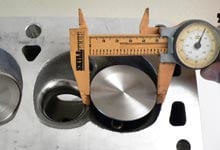
 The 200 an 215cc heads come with 2.08" intake and
1.60" exhaust valves. The 180cc head is listed with
a 2.02" valve but ours for some reason arrived with
2.08" seats and valves.
The 200 an 215cc heads come with 2.08" intake and
1.60" exhaust valves. The 180cc head is listed with
a 2.02" valve but ours for some reason arrived with
2.08" seats and valves. |
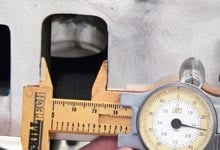
 The port height and width on the 215cc head are 2.15"
x 1.25" (use a FelPro 1262 gasket.) The 180cc head
measures 2.00" x 1.15" (use a FelPro 1250).
The port height and width on the 215cc head are 2.15"
x 1.25" (use a FelPro 1262 gasket.) The 180cc head
measures 2.00" x 1.15" (use a FelPro 1250). |
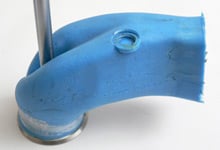
 We pulled molds of the 215cc intake runner (shown here)
and the 180cc runner (right) to enable a better view of
runner and port differences. Note how the 215cc runner
has a taller roof and wider cross-sectional area (use
the impression of the rocker stud boss as a point of reference.)
We pulled molds of the 215cc intake runner (shown here)
and the 180cc runner (right) to enable a better view of
runner and port differences. Note how the 215cc runner
has a taller roof and wider cross-sectional area (use
the impression of the rocker stud boss as a point of reference.) |
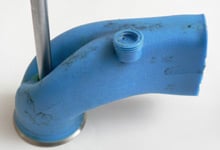
 This is the RHS 180cc runner. The smaller dimensions keep
velocity up, which is critical for a stock displacement
street motor. As you'll see on the next page the 180cc
head flows well up to .535" lift.
This is the RHS 180cc runner. The smaller dimensions keep
velocity up, which is critical for a stock displacement
street motor. As you'll see on the next page the 180cc
head flows well up to .535" lift. |
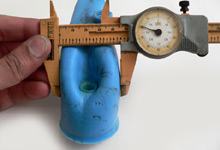
 The widest portion of the runner area on the 180cc head
measures at 1.800".
The widest portion of the runner area on the 180cc head
measures at 1.800". |
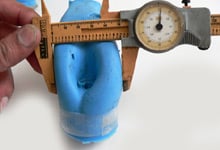
 The widest portion of the runner area on the 215cc head
measures at 2.020". The 215cc head takes off in flow
after .500" valve lift.
The widest portion of the runner area on the 215cc head
measures at 2.020". The 215cc head takes off in flow
after .500" valve lift. |
Flow Testing with the Pros
We took the heads over to Watson Racing and Engineering LLC.
in Concord, CA. Watson Racing is the brainchild of NHRA Pro-Stock
racer Ben Watson. Calling it a machine shop doesn't do it
justice. This place is 26,000 sq.ft. of pure high-end race
engine development. More on this on the next page. Ben, who
is busy 24/7 working on the Dewco Pro-Stock GTO, put us in
touch with Mike Blackstone, the engine building and cylinder
head porting guru. We immediately felt foolish with a set
of as-cast heads going on a bench that sees heads with hundreds
of hours of Mike's port work. Fortunately for us Mike is a
knowledge junkie and was just as interested as we were in
how the RHS heads would fare. More
|